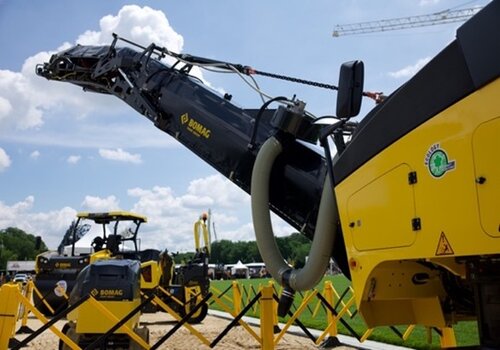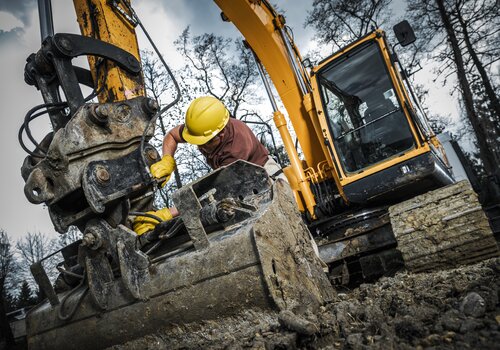If you want more uptime, lower overall operating costs, greater resale value, and a longer life for your skid steer, preventive maintenance (PM) is key. Experts from Caterpillar, Case, and Wacker Neuson have all the PM maintenance tips you need for skid steers.
1. Make it a habit to check these things every day
Operators should start each workday with a daily walk-around inspection in which they:
- Check fluid levels (hydraulic fluid, fuel, coolant, engine oil) to make sure they are in the operating range specified in the owner’s manual.
“Fluid levels can have a significant effect on the machine’s performance and can lead to overheating a particular system, loss of machine performance, or even downtime,” says Kevin Coleman, senior product specialist at Caterpillar.
- Check the filters (engine air filters as well as cab filters).
“Owners who are diligent about following filter maintenance intervals are the ones who will see the least amount of downtime,” says Fred Paul, Wacker Neuson University manager. “By utilizing high-quality fuel, oils, and OEM filters, the owner is in a position to maximize uptime and productivity.”
- Inspect for leaks and look for fluids gathering anywhere inside the engine compartment, but also look for fluids in other places.
“Whether on the ground, in the engine compartment, or on the machine itself, pooled fluid tells a story that should be investigated,” says George MacIntyre, product manager for CASE Skid Steers and CTLs. “Identifying the source will help you identify possible damage or repairs that can be made before they become more costly downtime events.”
- Inspect the fuel and water separator bowl and drain any water and apply grease to all greasing locations.
- Check all hoses for damage or wear, and confirm all safety guards/braces are present and in working order.
- Verify that the fluid compartments are sealed with the proper caps and remove any debris from the machine (engine compartment, around axles, etc.)
- Check tires for wear or damage and for proper inflation.
Tire inspection is key for skid steer loaders. “Flat or underinflated tires can affect the machine’s safety and performance in addition to leading to downtime,” says Coleman. “If you have a low tire when you lift a load off the ground it can make the machine very unstable,” adds Paul.
“Make sure to clear any debris that is caked around the tire, because it can lead to excess wear during operation; or it can freeze during winter weather,” says MacIntyre.
In addition to the skid steer itself, MacIntyre also suggests checking for damage on all the components that do the work and make contact with the ground, including buckets, teeth, blades, and hammers. “Look for signs of stress or wear that could slow down operation.”
The daily walk-around inspection needs to become a habit. “A report from the operator(s) to the foreman on their machine’s condition and any concerns could be a bullet item for the daily meeting before the work shift starts,” says Coleman.
“Repetition builds consistency – making the walk-around inspection part of your daily activities and training every new team member to do it from their first day on the job is one way to make sure it’s being done properly,” says MacIntyre. “Explain to team members WHY these activities are important and the effect they have on uptime, profitability, and productivity – that understanding is motivating.”
2. Don’t skimp when it comes to fluid sampling
According to MacIntrye, fluid sampling is an often-overlooked practice that can tell you a lot about the health and performance of your machine. CASE recommends engine oil samples be sent for analysis every 250 hours, hydraulic and transmission fluid every 250-500 hours, and coolant be tested annually.
Owner’s manuals will include the recommended intervals for your machine.
“The important thing is to take oil samples regularly, so that changes can be identified, the correct diagnosis made, and remedial measures are taken,” says Coleman. “Fluid sampling will also help an owner to monitor the total health of the machines.”
According to Paul, fluid analysis has become a part of routine preventative maintenance programs for many contractors or rental houses with sizable fleets. “Owners can see trends related to wear, and effectively plan for higher levels of maintenance or replacement,” he says.
MacIntyre believes fluid sampling is especially important if a machine has had previous owners, or has been used across numerous job sites. “It’s often those unseen issues that can create the most unexpected downtime events,” he says.
When maintenance records provide a history of fluid sampling, it can be valuable when trading in your machine. “Fluid sampling may also allow for extended oil drain intervals for certain fluids, thereby reducing owning and operating costs,” says Coleman.
3. Tap into telematics
Without dedicated fleet managers, many small and mid-sized firms that own skid steers can find it challenging to schedule routine maintenance.
Basic telematics programs provide hour readings and location data that can help these businesses stay ahead of maintenance intervals. More comprehensive telematic solutions provide additional functionality for machine monitoring, health, and maintenance. “If a machine is equipped with the deluxe telematics version, and the machine alerts the operator with a problem, that same alert will be visible to the owner or mechanic at the same time,” says Paul. “This provides valuable diagnostic assistance early and can help the mechanic determine a course of action. Often this can save time and money on repair or maintenance costs and keep the machine operating at top performance.”
While the number of skid steer owners opting for telematics is relatively low in comparison with larger machines, MacIntyre sees an upward trend as equipment owners realize the advantages.
4. Get operators on board with maintenance responsibilities
Operators are the first line of defense when it comes to taking action on maintenance items. In addition to daily inspections, operators need to understand how to respond to in-cab alerts and messages. Most skid steers include a machine vehicle control unit (MVCU) that provides real-time indicators of machine conditions. The codes could indicate something major, or as simple as low DEF (diesel exhaust fluid). If addressed promptly small problems can often prevent larger problems.
CAT skid steers feature a full-color display with a menu selection that will allow the operator to see the maintenance schedule and the hours remaining before a particular service item is due. Additionally, “pop-up” reminders indicate that a scheduled maintenance interval is approaching.
Paul believes one maintenance item that may be overlooked is engine regeneration “Engines equipped with a diesel particulate filter (DPF) may require regeneration,” he says. “When regeneration cycles are overridden, or the machine is shut down during an active regeneration process it could cause the machine to enter a de-rated state until a qualified technician can correct the problem.”
“When an operator has “ownership” of a piece of machinery they tend to feel more involved with the company, have more pride in their work, and improved morale,” states Paul. “Owners who weave daily maintenance responsibilities into the operator’s task list will realize better functioning machinery, and reduced downtime.”
5. Consider options that reduce the burden of maintenance
Manufacturers and dealers are making it more convenient than ever for fleet owners to maintain equipment. A Cat Customer Value Agreement ensures that parts are delivered on time with instructions for maintenance. “Owners get the security of an Equipment Protection Plan (EPP) to avoid unexpected costs for unplanned repairs,” says Coleman. “All the keys to machine health management conveniently display on your phone. And it all can be rolled in with their monthly machine payment.”
“The advantages of customer service agreements are that it makes preventive maintenance activities one less thing that a business owner has to worry about,” says MacIntyre. “With so many things in the business requiring time and effort, it is an advantage to have a partner handling that for you.”
Wacker Neuson Service kits can be ordered prior to a scheduled PM so parts are on hand when the service is performed, reducing any downtime associated with the maintenance. Cat Self-Service Options offer a broad range of common repair options, packaged with everything a customer needs to do the work himself — in their shop or in the field.
Read Next
Rent, Lease, or Buy a Skid Steer? Here's How to Decide
Rounding Up the Best: 7 Skid Steer Models












